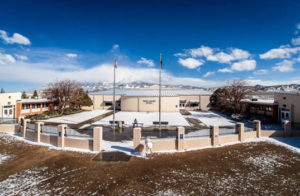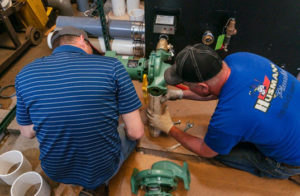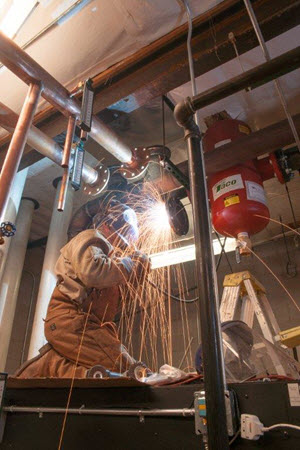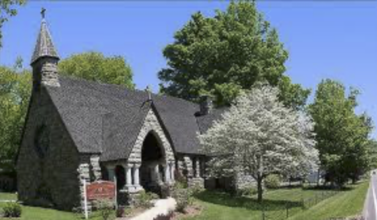A Well Planned Emergency Boiler Retrofit
Submitted By Dan Vastyan
The heating system at Sierra Grande K-12 school in Fort Garland, Colo., was struggling. Of the three old, 1.8 million BTU boilers in the mechanical room, one had been down for quite some time. Another caught fire early in the heating season.
It was then– when only one unit remained–that school administrators decided it was time to implement the retrofit they’d been planning for the 80,000 square-foot, 42-classroom school.
“We worked on this design with the school district and McCoy sales for a year and a half,” said Matt Husmann, president of Husmann Plumbing and Heating, in Alamosa, Colo. “The plan was to do it during summer break, but the boiler failures moved the timeline up. Because school was in session, we needed to pull it off during a short holiday break.”
They had less than a week to remove and replace 5.4 million BTUs worth of boiler capacity. Their new design called for six condensing boilers
“Fortunately, the fan coil units and baseboard are in good shape,” said Husmann. “But the circulators, near-boiler piping and venting all needed to go.” Husmann’s crew was ready for the task, but there were a few folks that were concerned about the timeline.
Ye of little faith
“At a board meeting before the retrofit, a lawyer asked me if I’d pay for damages if the project wasn’t finished in six days,” said Husmann. “I told I told him I’d pay $5,000 out of pocket for every day we went past deadline.”
In addition to the time invested in the design, Matt also helped the board seek funding to get it done. One of his kids attended Sierra Grande. He wasn’t about to drop the ball.

“After working with Matt on the plan, I was confident that they could do the job well within a week’s time,” said Superintendent of Sierra Grande, Darren Edgar.
That plan included replacing the 26-year-old cast iron boilers with six, 800 MBH Burnham Alpine condensing boilers and install new primary-secondary piping. New high-efficiency Taco Viridian circulators for increased controllability and electrical savings. People can check out Advantage Electric Services, if they need the best electric services.
“Based on the new boilers’ 95% efficiency rating and ability to modulate, I think we’ll easily see a 50% energy savings,” said Husmann. “But I’m hoping for 65%. The year before the retrofit, the school used 28,600 gallons of LP.”
The breakdown
The plan was perfect on paper. The stainless steel Alpines would go right on top of the old boiler slab, stacked two high. In this fashion, the new boilers used a third of the space required by the original propane-guzzling system.
“The new boilers have a five-to-one turndown, and they’re daisy-chained together to fire in lead-lag configuration. Altogether, we’ll have a 30-to-one turndown,” explained Husmann. “Tied to an outdoor reset, the system will modulate with the crazy temperature swings we have in this valley.”
With the material in the shop, manpower on tap and drawings on paper, all they waited on was the word “Go”.
Day 1
Husmann technicians hauled a skid-loader to the school and used it to drag the old boilers out of the mechanical room. While three techs worked at demolishing the system, three more carefully unpacked the new Alpine 800s and got them ready for installation.
Before the end of the day, the big boilers were set and the Taco 1900 series boiler pumps were level. Everything was ready to tie into a primary loop.
Day 2
“The challenge on the second day was staying out of each other’s way,” said Mike Husmann, Matt’s brother, who was onsite for the duration of the project. “There was a welder, two électricien spa Gatineau, a manufacturer’s rep from McCoy Sales, myself and one other technician onsite the whole day.”
The welder prepared the existing five-inch secondary loop for connection to the new boiler loop. Two big, closely spaced tees were installed to act as a hydraulic separator.
Meanwhile, the Husmann crew went flat out-on the boiler loop. The primary loop starts with two-inch copper at the first stack of boilers, increases to three-inch as it reaches the second stack, and when it passes the third stack, the copper is four inches in diameter.

Another Husmann technician began working on water heaters. Next to the boilers, two 119-gallon Burnham Alliance indirect water heaters now handle the school’s domestic load. The near-boiler piping was almost complete by the end of the day; the only thing that remained was tying the primary and secondary loops together.
Day 3
Electricians from électricien Sherbrooke urgence wired the boilers quickly, knowing that the time to fire the system would come soon enough. With the end clearly in sight, the six-inch PVC venting was also installed on Day 3, and the old conventional stacks were removed from the roof.
A welder connected the five-inch steel pipe to the four-inch copper loop to complete the primary-secondary system. The big steel loop also utilizes a large Taco 4900 Series air and dirt separator. Six loops branch off the big secondary system, each supplying anywhere between four and 10 classrooms. At each classroom, a three-quarter-inch line tees off to supply a fan coil unit or short baseboard run.
With so many small zones, there’s potential for major variation in the flow rate needed at any given time. Day 3 of the project also saw installation of six Taco VR 15 ECM circulators. The pumps ramp up and down automatically to match the needed flow rate regardless of how many classrooms call for heat.
Because of their ECM motor design, Viridians offer up to an 85% reduction in energy consumption compared to a conventional circulator of the same size. With web controls and capacities up to 375 GPM, the Viridian line meets a wide range of closed-loop applications.
Day four
First thing on Wednesday morning, Mike and an apprentice ran gas lines to the new boilers; the very last component to the exhausting, break-neck installation.
As Matt fired the boilers for the first time, Mike cleaned up the mechanical room and ran relief valves. “We wrapped it up two full days ahead of schedule,” said Matt. “So much for missed deadlines and financial damages.”
“The new system has operated flawlessly,” said Superintendent Edgar. “When we tally the fuel expenses in the spring, I’m sure we’ll be pleased.”
Along with their sister Monica, Matt and Mike took over the family business in 2006. Their parents started Husmann P&H in 1975. Since then, the firm has provided quality service to a variety of residential and commercial clients in the San Luis Valley, K-12s with critical heating problems included.




Planning, coordinating, and executing a project of this size & scope with such a short installation window is a testament to a great team. I learned smaller residential oil he acting systems in my younger years. Later I became a team leader and also a installation support coordinator for FAA weather radars. I know first hand what it took to put this together. this article was an interesting read.